I finally practiced what I preach by taking on my first ultramarathon. Having worked as a Sports Scientist and Performance Coach with England and Chelsea football teams, Leinster Rugby, Lululemon, and a host of endurance athletes, I thought it was time to put in the miles myself.
I took on the Ultra X Scotland - a 50k race that runs along Lough Ness and back in towards Inverness. In this article, I explain how I put the science of pre-race carb-loading, in-race fueling and proper post-race celebrations into practice…
The Carb Load
Given my background is steeped in scientific research and applied experience of working with peers and athletes at the cutting edge of performance, I used an ‘evidence-informed’ approach to prepare my fueling strategy.
As we all know, carbohydrates are the essential fuel for athletic performance. I simplified my own carb intake by focusing on consuming a sufficient amount of carbs and getting the timing right. This is particularly important in the final few days before race day…
A common acronym used in team sports, such as football, is speaking relative to Match Day (MD). This is useful as often the day of the week is irrelevant and with high competition density and rapid turnarounds, this is a best-practice way for athletes and coaches to have clarity on the intention of each day.
For Ultra X, let’s consider my Race Day as RD, and days either side of race-day are noted as RD-1 or RD+1 for the day before and after, respectively.
The goals of the week leading into a race are typically to taper and prepare yourself as best as possible. I won’t go into tapering in this article, but the general principle is to reduce volume in the week leading into your race. Where possible, I’d also advise trying to reduce other stressors so that you go into a race as fresh as possible.
For my race week, you’ll see in the figure below a large uptick in my carbohydrate intake on RD-2 & RD-1.
I completed four short sessions the week of my race, and so you’ll see a slightly higher carbohydrate intake on the days I ran compared to the days I lifted weights.
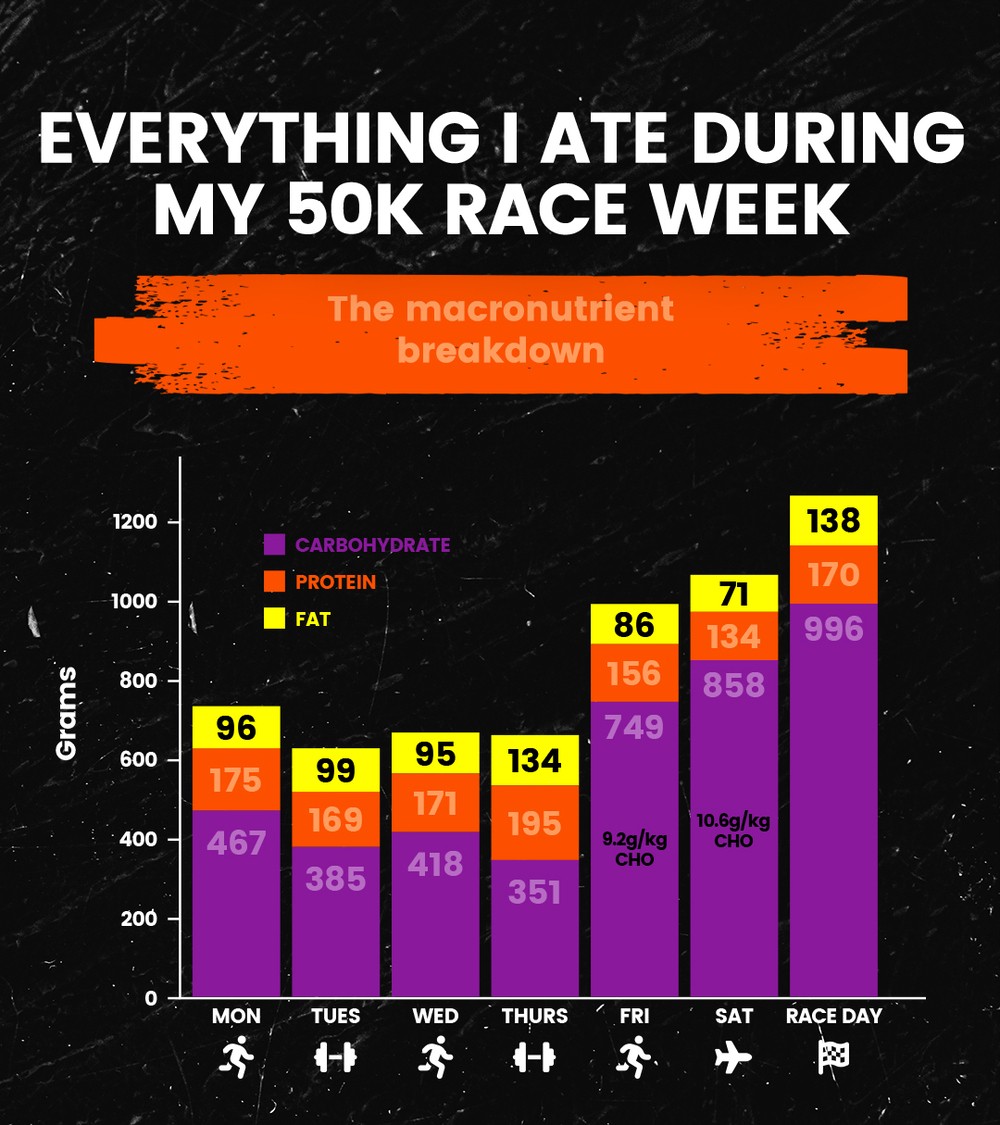
Carb-loading on RD-2 & RD-1 is a strategy to maximise glycogen stores in the body before competition to ensure your body has sufficient fuel for your race.
Research has shown that appropriate carb-loading can delay fatigue and improve performance. Whilst historically athletes may have attempted a longer carbohydrate loading phase (~5 days) and even a few days of depletion prior to loading, it’s now strongly considered that 24-48 hours of carbohydrate loading can sufficiently saturate muscle glycogen stores.
The recommended carbohydrate intake is always relative to body weight, and is currently 8-12 grams of carbohydrate per kg of bodyweight.
So, considering I weigh 81kg, my recommended carb intake for RD-2 & RD-1 was 648g-972g of carbohydrate. On RD-2 I consumed 749g carbs (9.2g per kg of body weight), and on RD-1 I consumed 858g carbs (10.6g/kg).
RD-1 (Travel Day)
On RD-2 & RD-1, I tried to get a lot of calories from drinks, chews and sweets. There are plenty of options you can find in public stores, and it’s always a good idea to be organised and carry with you what you plan to eat and drink when travelling for a race.
The following table is everything I ate on my RD-1 when travelling, as well as the macronutrient breakdown and timings too. Is everything perfect? Nope. But on this day, I had to contend with travelling to the airport, a short flight, transport to our Airbnb, race check-in, and meeting up with some friends.
One intentional decision I made was to eat dinner in our Airbnb, instead of eating out. This gave me a little bit more control over what I could put on my plate.
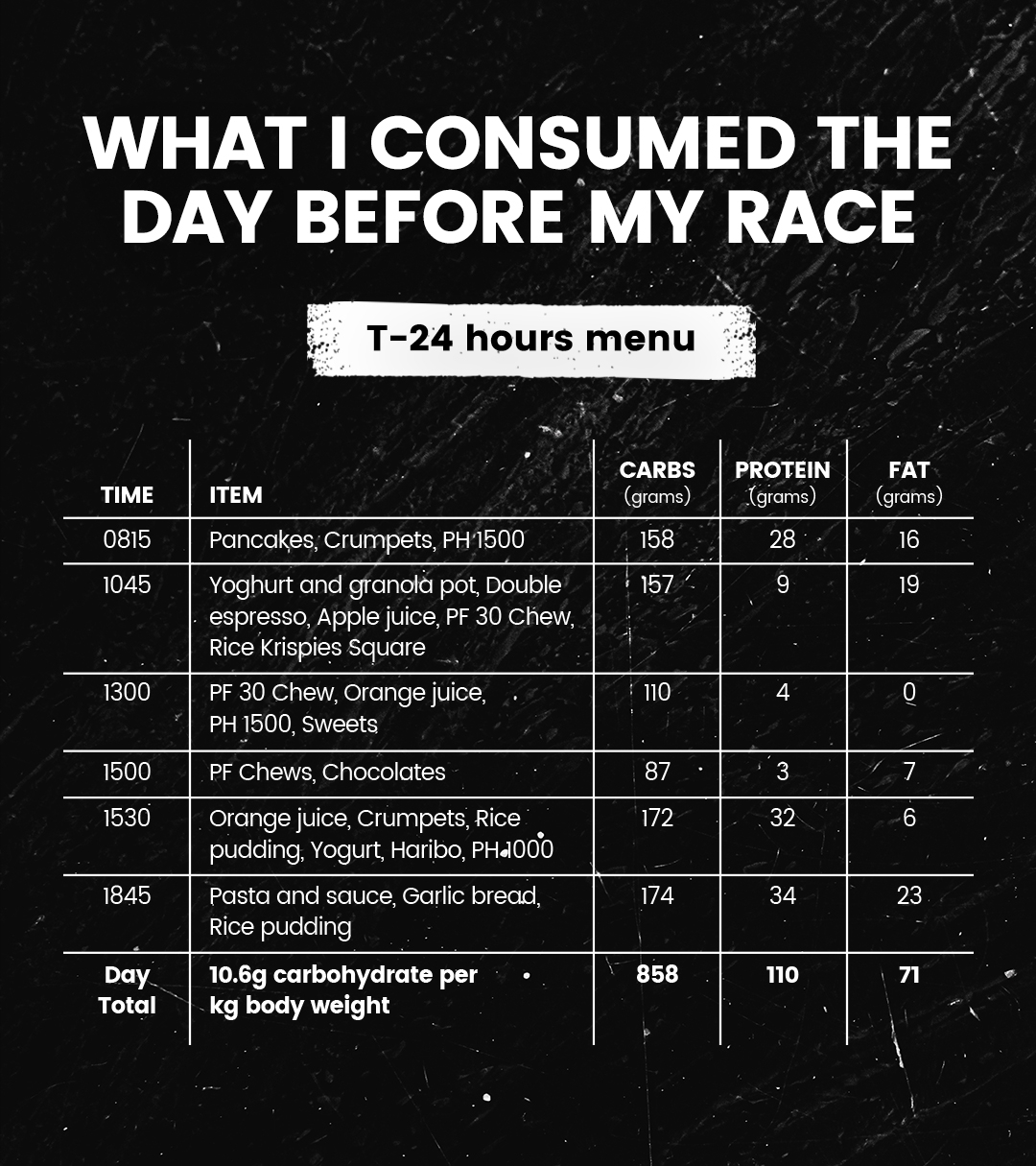
On RD-2 & RD-1, in order to achieve my carbohydrate goals, I used a few guiding principles:
- Eat frequently. I personally have found this helps with digestion and reduces the burden of trying to have three enormous meals
- Liquid carbohydrates, gels and sweets are your friend
- Lower protein, fat and fibre intake
- Plan. It's harder to eat 8-12g of carbohydrate per kg than you might think! This is a lot of carbs
- I find that small frequent bouts of movement (walking, stretching) can help avoid some of the energy slumps that you might associate with such a high carbohydrate intake. At this point, I just wanted to get going, so they also helped me feel good before the race!
Travel considerations
I don’t live in Inverness, so I had to travel for this race. For me, it was a relatively straightforward flight from London on RD-1. Travel is an important consideration for many athletes in sport prior to competition, most likely on RD-2 or RD-1. For some people in specific contexts, you may be able to arrive earlier than this relative to race day - but many don’t have that luxury.
Since I was flying on RD-1, this was one of two key carb-loading days for me to ensure I went into the race well-prepared.
In the airport, I had a look around at some ‘on the go’ carb sources that were low in fat, fibre and protein (this is typically the opposite of what I normally look for when travelling!). Consider products like bottles of juices and smoothies and sweets. I settled for a Pret Yogurt and Granola Pot, Double Espresso, Fruit Drink, Apple Juice, PF 30 Chew, and a Rice Krispies Square. I’d recommend taking a few minutes to browse shops and restaurants until you find something suitable.
Alternatively, plan ahead and bring your own carb sources with you - PF 30 Chews are my personal favourite.
I’m always conscious of staying hydrated when travelling, particularly on planes. I had a PH 1500 electrolyte tablet in 500ml (16oz) of water. I would definitely advise drinking electrolytes when flying to a race.
This flight was just over an hour. After half an hour, I got up to stretch and move around after eating some more carbs. Although not the purpose of this article, stiffness is often a big issue when travelling. So I always advise some movement and mobility work to mitigate against this.
If you’re driving to a race, plan some 5-10 minute stops along the way to stretch and move around. If you’re on a train or plane, opt for an aisle seat so you can get up and move around every 30-60 minutes.
Race day fueling
Generally, the recommendation would be to consume ~1-4g of carb per kilo of body weight in the 1-4 hours prior to race start. I would strongly suggest trialling this before some long-training sessions. The body's response to certain foods is different for everyone, and can vary wildly in the acute period before a race. If I had less time before a race, I would probably reduce the foods I ate to mostly liquids, chews and gels.
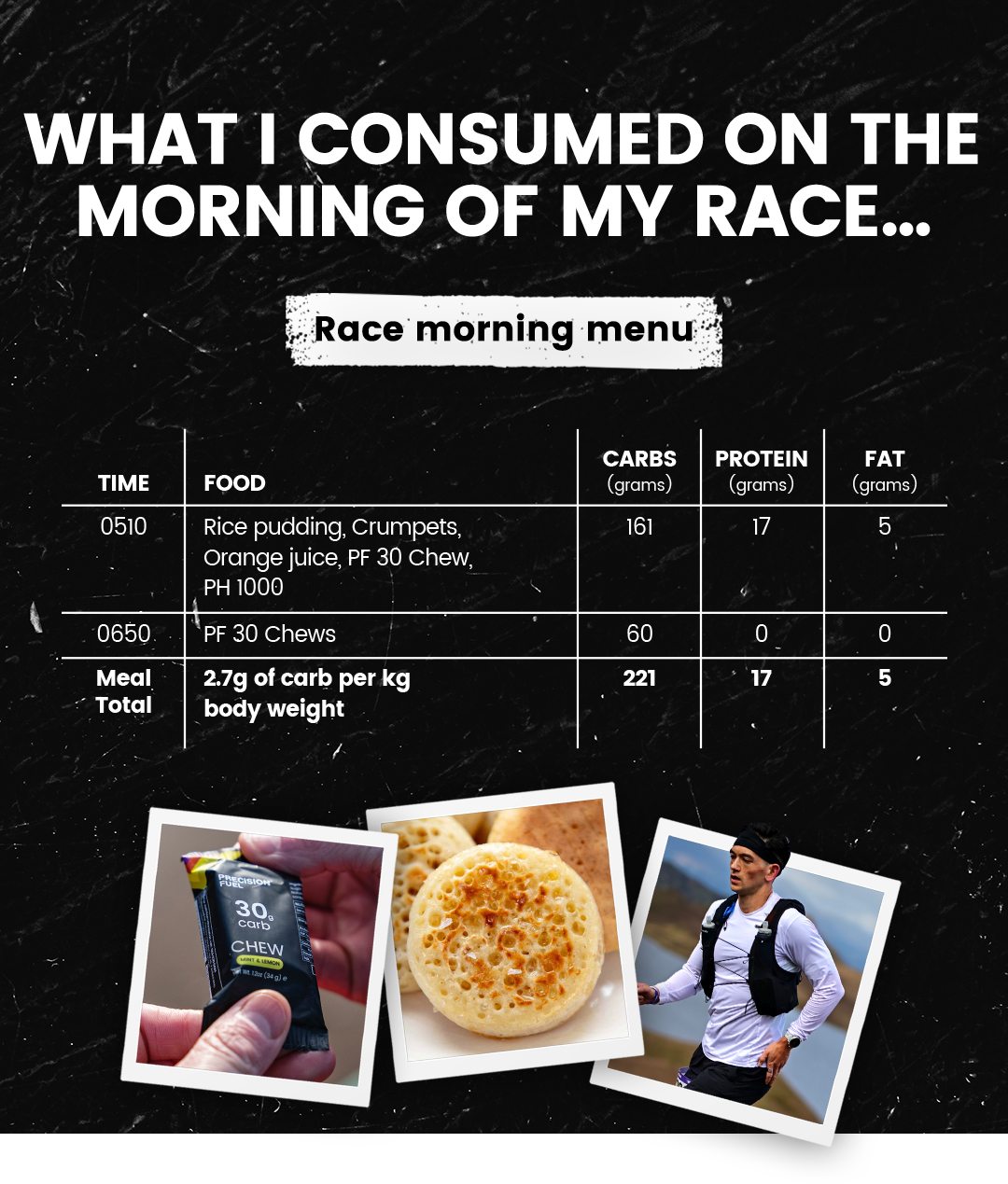
Pre-race, I managed to consume about 3g of carb per kg of body weight in the 3 hours pre-race.
This consisted of a larger breakfast of apple rice pudding, crumpets with honey, orange juice, PF 30 Chew, plus two packets of PF 30 Chews on the way to the start line. I then had one PF 30 Caffeine Gel ~15 minutes before the race.
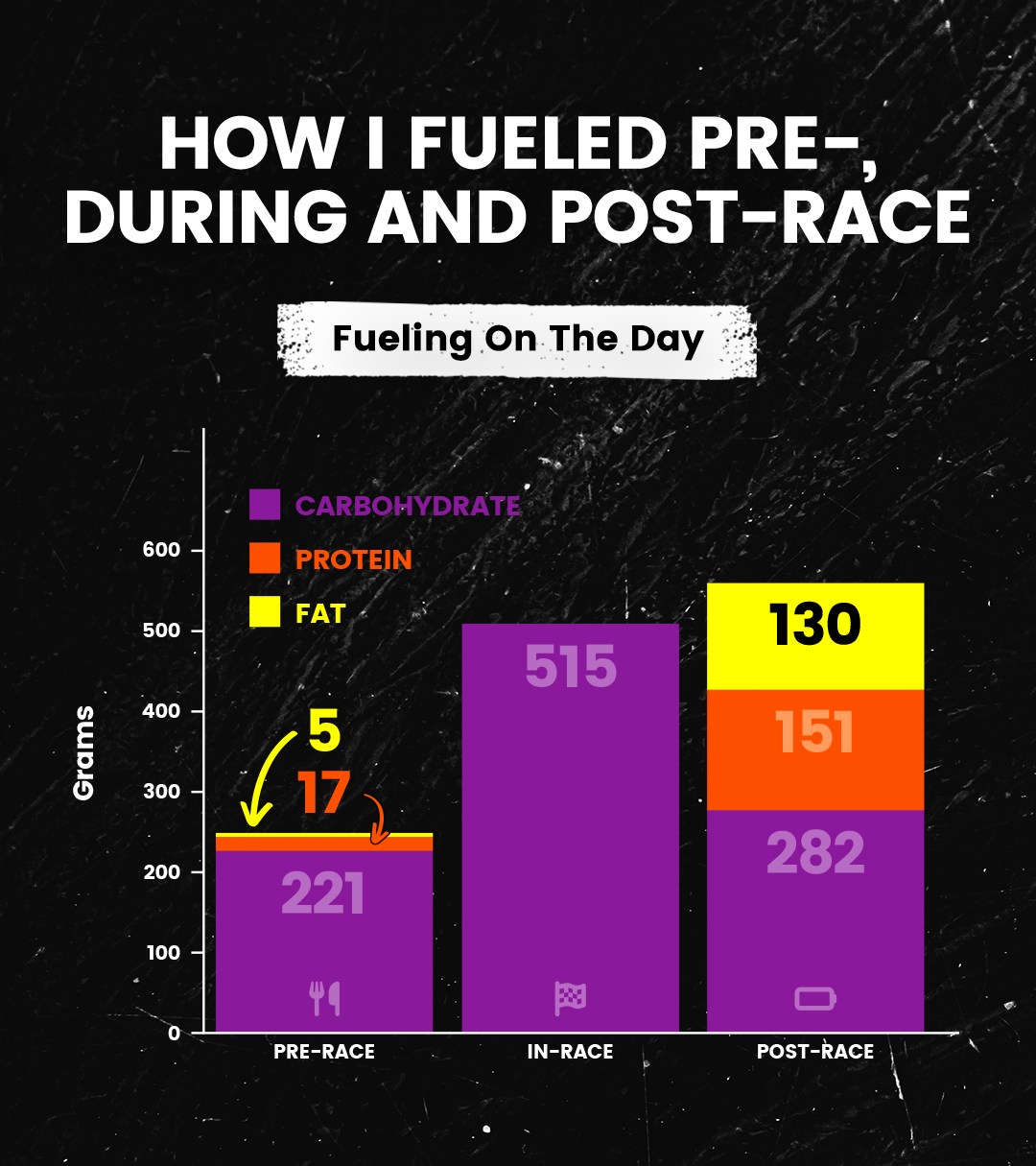
Scottish weather is hard to predict. But, aside from a cold and windy start line, this event ended up being a very cool, dry and calm day, with an average temperature of 9°C (48°F). For someone with a high sweat rate like me, that was a good thing!
Due to the cooler conditions, I knew I wouldn’t be drinking too much, which was one reason I relied almost exclusively on gels to hit my carb numbers during the race.
I alternated between PF 30 Gels and PF 30 Caffeine Gels for the first couple of hours, before taking ~30g of carb every 20 minutes from a PF 90 Gel during the third hour.
I’d decanted PF 30 Gels into a PF Flow Flask 120 before the race and then relied on this, alongside a soft flask of Carb Only Drink Mix, during the final couple of hours.
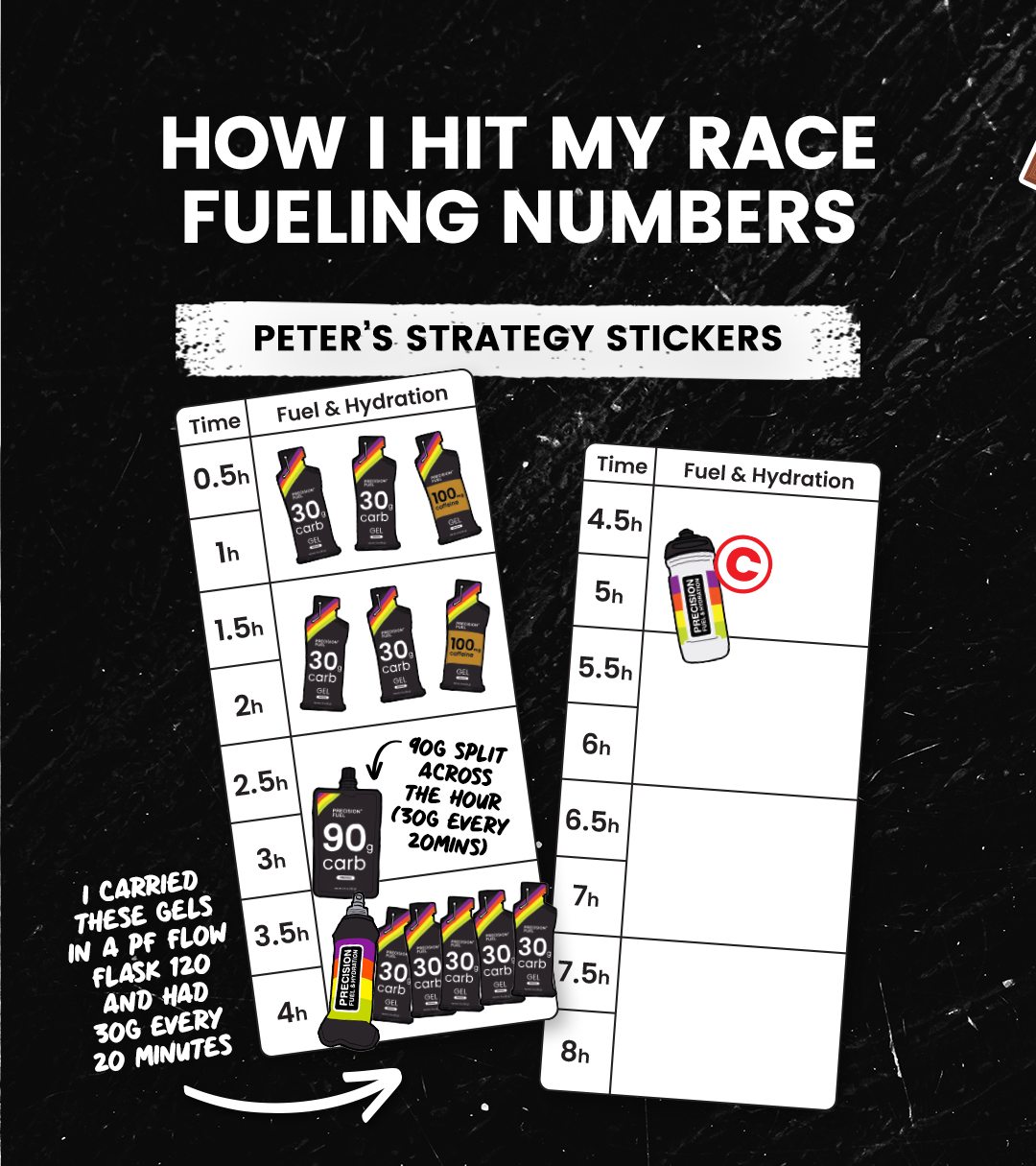
The focus for me is really just to maintain carbohydrate intake to maintain glucose availability. Carbohydrate intake also has benefits linked to the nervous system and mitigating against cognitive performance decline too.
The Fuel & Hydration Planner suggested I should be aiming for between 60-90g of carb per hour, although some athletes can exceed this and reach ingestion levels of greater than 120g/ hour.
Please make sure to test this high level of intake during training sessions to train your gut. Factors such as intensity, duration, performance goals, and logistics of carrying your fuel can all contribute to deciding what your intake will be during a race.
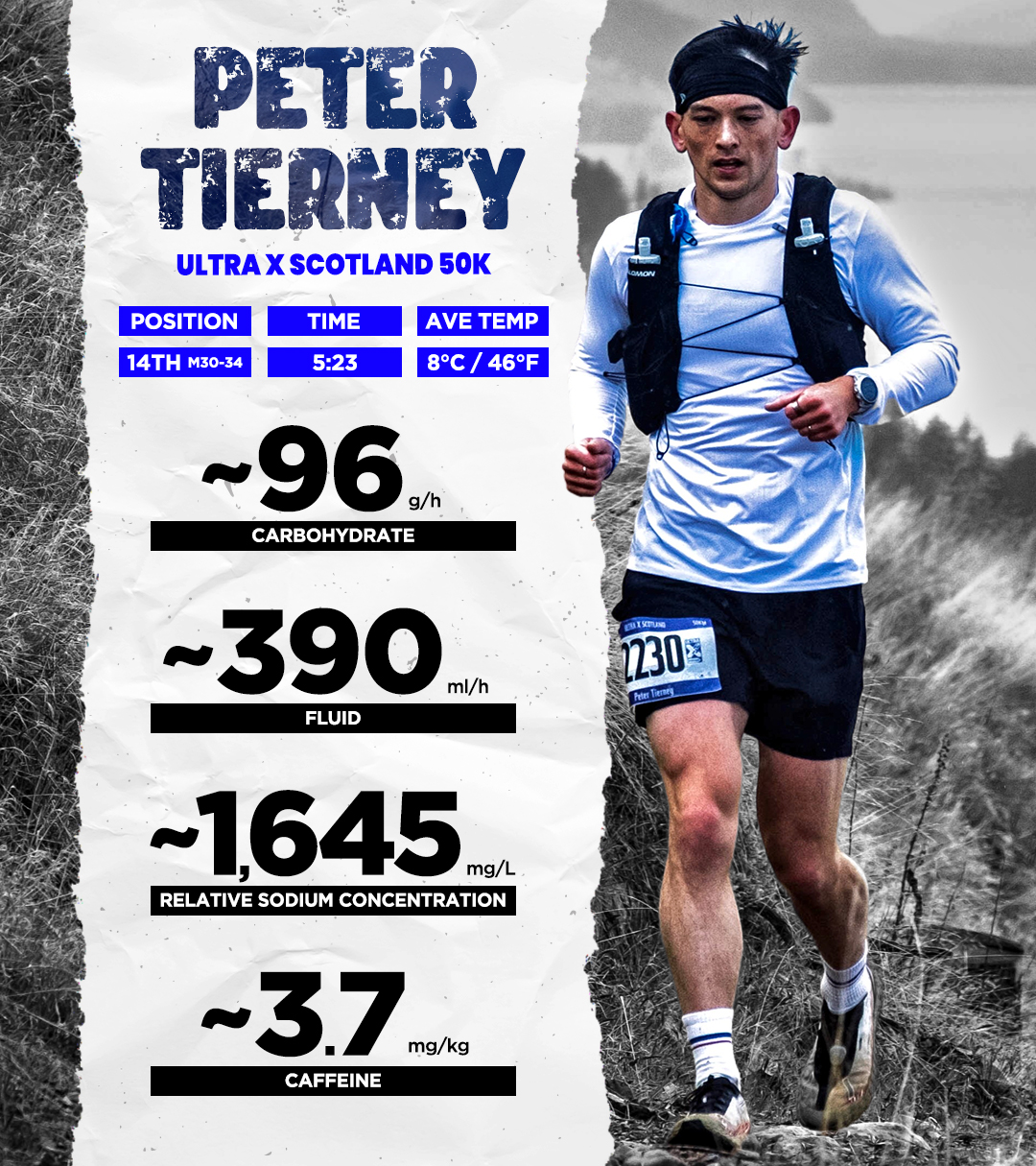
If you do struggle to take on sufficient carbs later on in a race, you can also consider a carb mouth rinse. There are some reported benefits to swirling carbs (without swallowing) - and so I’d definitely consider this if you're having stomach issues. Just please clean your teeth well after the race!
Post-Race
In simple terms, you’re trying to replenish what you've lost during the race from a fuel and fluid perspective post-race.
Primarily, the main macronutrients to focus on are carbohydrate, then protein, then fat.
Post-race eating can be challenging for many people - depending on the race you've just completed, you may have been slurping gels and drink mixes for 3-5 hours (or far more), and the last thing you want is another gel or drink mix! I sometimes find that my appetite is a little suppressed after longer runs, but on other occasions I feel like I can eat anything.
After this race, I found a nice pastry from one of the food trucks at the race finish, and also a banana, sea salt snack and a recovery shake. I had these whilst I caught up with friends and cheered on some other runners.
At many races, there will be some decent post-race food and drink options. When you’ve had the chance to catch your breath, I would highly recommend looking for a good source of protein and carbs. In many races there will be food trucks, sponsored products, and a range of fruit, bars and other snacks. If you have any food intolerances, allergies, or are just a little fussier, you might need to plan ahead to bring things you like. On the way home to the Airbnb, we found a food market and grabbed some chicken.
Later on that evening, the group of us that travelled for this race had dinner together. I had salmon, roasted potatoes, croquettes, broccoli (and a glass of beer). Dinner ended up being lower carb than I would have liked, so I walked to the shop and got dessert which was ice cream, chocolate milk and chocolate bar.
For most people, the turnaround between a race and the next session or performance isn’t that close, and so I think you can relax a little bit in terms of numbers. However, in a period where you're racing again not longer after your race, or if you're a team sport athlete who needs to perform again within a couple of days, this post-competition window is essential to focus on. Also, no-one wants to be walking around with sore legs for a week after a race!
A ratio that is typically recommended is ~1.2g of carb per kilo of bodyweight each hour during the initial recovery period (or think of this as 3g/kg within 3 hours). If you think this is difficult to achieve, adding protein to carbohydrate during post-exercise recovery might be beneficial for restoring muscle glycogen, when carbohydrate intake is lower (<0.8g/kg per hour).
One consideration for after the race (maybe not immediately after) is fat intake. I find ingesting fat (some ‘healthy’, and some ‘unhealthy’) is a good way to ensure I meet my caloric needs for that day.
The likelihood is you won’t want to think about counting carbs, macros and meal timing on these days. My hunger levels were through the roof after this race and I craved vegetables after ignoring them for a few days in the build-up to race day!
Having talked the talk for so long, I'm delighted to have walked the walk. I'm already looking at the calendar for my next ultra challenge...
6 Key Takeaways
- Carbohydrate loading and sufficient fueling and hydration isn't something you can just do on race-day. It requires careful planning in the days leading up to your race
- On RD-2 and RD-1, aim for around 8-12g of carbohydrate per kilo of body weight per day. Use drink mixes, juices, chews and sweets to help you achieve that goal (whilst reducing fat and fibre intake) - Note: this is more food than you might think!
- On RD, aim for around 1-4g/kg in the 1-4 hours pre-race. Trial this to see what works for you
- During the race, work out how much carb per hour is optimal for you. This will vary depending on race duration and intensity, as well as your own tolerance and gut training
- On RD, immediately post-race, aim for 1.2g/kg per hour of carbohydrate in the 1-3 hours post race. Add in protein of 0.4g/kg per hour. Think of a 3:1 carb:protein ratio to make things easier
- For the rest of post-RD, try to accumulate sufficient calories to match your energy expenditure for that day. Consider fueling to repair and recover on RD+1 and RD+2
